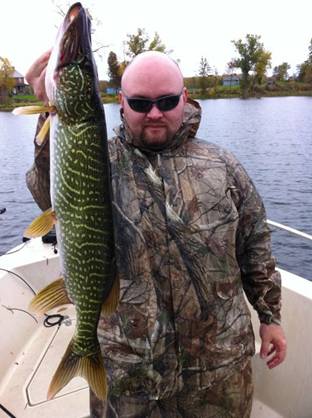1) Chain Pickerel does not have any markings in their fins.
Your fish has defined markings in all its fins. The black markings in the tail, dorsal and anal fins are especially evident in your fish.
2) Chain Pickerel has a distinct black "teardrop" below the eye.
Your fish's head is rotated away from the camera, so it is a bit difficult to tell. However, if that teardrop is there, it should be very, very obvious, especially since it extends from the eye diagonally back toward the corner of the jaw.
3) Head of Chain Pickerel is comparatively longer and larger.
The head in your fish does not appear long or large enough.
4) Northern Pike has 5 or less pores under the chin.
Although there appears to be 4 pores on the one visible side of the chin in the picture, it doesn't fully rule out Northern Pike. Northern Pike usually has 5 pores on each side, but it is possible for them to have less as well. Also, the pores in Chain Pickerel does not extend as far back as Northern Pike. In your picture, the last pore is found behind the corner of the jaw. In Chain Pickerel, the last pore is found in front of the corner of the jaw (unless the rare Chain Pickerel which could have 9 pores).
* I cannot see if there were indeed scales on the gill or not, and how much of the gill cover was scaled. Northern Pike has scales on the gill cover but the scales are restricted to the upper half. Chain Pickerel has scales on the entire gill cover. Both species have scales on the cheek.
Thus, I would say, unfortunately, this does not appear to be a Chain Pickerel based on all these features mentioned here, despite the body markings.
I hate to use the H-word...Hybrid...unless the morphological features suggest it was a mix between the two species, and if there was DNA evidence to confirm it. Plus, E. lucius x E. niger usually has a very unique pattern - alternating thin vertical broken stripes with thin vertical column of evenly spaced small spots. These stripes and spots are diagonal and forward pointing below the lateral line.
For example:

* Taken from http://nyfisherman.net
Note the pattern, the dark teardrop under the eye, and the clear fins without any patterns (fin rays may appear as "patterns", but Northern Pike's black markings on the fins are much thicker and much more randomly distributed as a mix of thick spots, bars and vermiculations).

























